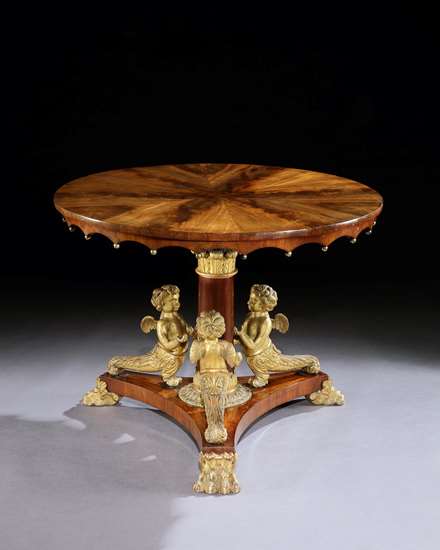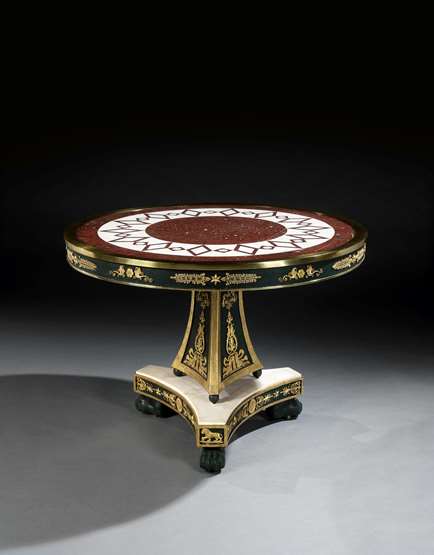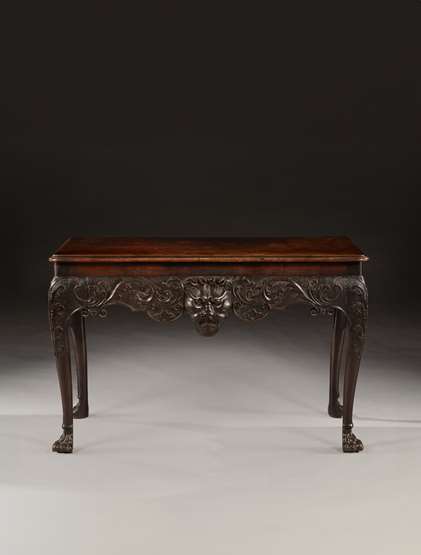A Pair of Card Tables attributed to Thomas Chippendale Junior
English, circa 1782
For William Constable Middelton of Stockeld Park, Yorkshire
REF 861
H: 30 in (76.5 cm) W: 36 in (92 cm) D: 18 in (45.5 cm)
The semi circular top elaborately decorated with a fan in holly and purple wood, centered by finely engraved leaves and divided by graduated bell flowers and swags of laurel centered by circular paterae cross banded in satinwood and tulip wood. The top opening to a baized lined interior cross-banded with satinwood.
The frieze finely carved in solid satinwood and centered by a crest of the Middelton family finely carved in boxwood. The four legs fluted and with lobed capitals, terminating in turned spade feet.
DESCRIPTION
The Middelton Family
These card tables bear the crest of the Middelton family, of Stockeld Park, near Wetherby, Yorkshire. A long-established Yorkshire family based originally at Ilkley in Wharfedale, the Middeltons later made Stockeld their principal residence, and in 1757 William Middleton (1707-63) engaged James Paine to rebuild it in the Classical style. Middelton died before the house was completed and the house, estate and Middelton name passed to an infant great-nephew, William Constable (1760-1847), who took the name of Middelton. In 1782 William Constable Middelton married Clara Grace, the daughter of an Irish landowner from County Laois. It is probable that these tables formed part of a refurnishing scheme at Stockeld undertaken at the time of the marriage.
Despite producing six surviving children the marriage was not a success and ended in a celebrated divorce suit in 1793, caused by Clara’s infatuation with a household servant. William left Stockeld to live in Middelton Lodge, Ilkley, leaving the house empty for at least two decades before it was let to a succession of new owners. In 1893 the house was sold to a Bradford mill owner, Robert John Foster. During the 19th and 20th centuries a succession of poor financial decisions led to repeated sales of land and chattels, and it is likely that this pair of tables left the Middelton family during this time.
Thomas Chippendale Junior (1749-1823)
Thomas Chippendale Jnr took over from his famous father when the latter died in 1779, and the firm continued to supply the highest quality furniture to its many clients until 1813.These tables embody the mature and sophisticated neo-Classical style which the Chippendale firm had been developing in the late 1770s and which reached its fullest expression under Chippendale Jnr in 1780s. The tables’ design corresponds to a number of documented pieces supplied to clients during the 1780s and includes several signature motifs. These include the tapered, reeded legs with distinctive flared ‘petals’ at the top; the inlaid spiralling flowers or paterae which punctuate the segmental veneers of the half-round top; and the large engraved half-flower at its centre. In some cases, as here, the centre of the half-flower is made of a tightly-knotted burr veneer. The most direct analogies among documented furniture are with the Paxton House Drawing Room pier table of 1789 and the Stourhead ‘Weeping Women’ commode of 1780-85, but the closest resemblance of all is to an undocumented commode formerly in the collection of Norman Colville and last sold at Christies in 2001.
The primary veneer of the top is holly, laid in radiating segments terminating in curved panels of contrasting purplewood. The crossbanding is satinwood and tulipwood, and the finely-engraved foliage and flowers were originally dyed in colours of green, pink and white. The fluted frame and legs are solid satinwood with the exception of the central medallion with the finely carved Middleton crest, which may be boxwood.
We would like to thank Dr. Adam Bowett for his kind contribution to the research of these tables.
YOU MAY ALSO LIKE
A Pair of Card Tables attributed to Thomas Chippendale Junior




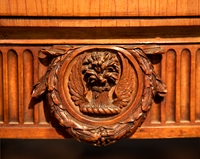
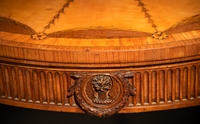


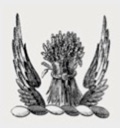

 PRINT
PRINT SHARE
SHARE